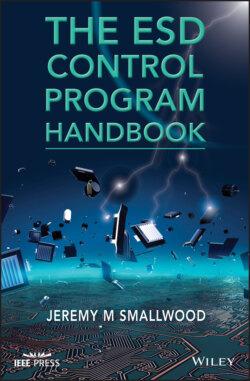Читать книгу The ESD Control Program Handbook - Jeremy M. Smallwood - Страница 46
2.2 Contact Charge Generation (Triboelectrification)
ОглавлениеThe first thing to state is that charge is never generated, nor is it ever destroyed. The phenomenon that we often describe lazily as the “generation” of charge is more correctly “separation.” Some practitioners speak of the charge being “liberated” or “set free.” The charge is initially present in the atoms that make up all materials. There are positive charges as protons in the atomic nucleus, and there are negative charges as electrons around the nucleus. Normally these are present in equal numbers so that in an uncharged atom the number of positively charged protons equals the number of negatively charged electrons present. Static electricity arises when an imbalance is created and the local amounts of positive and negative charge become different.
In practice, the amount of charge imbalance required to give strong electrostatic effects is surprisingly small. The limit of the amount of charge that can be built up on a surface is governed by the electrical breakdown field strength of air, around 3 × 106 V m−1. The surface charge density required to give this field is only 2.64 × 10−5 Cm−2 (Cross 2012). This is equivalent to about 1.7 × 1014 electrons m−2, or 8 atoms per million on the surface acquiring or losing an electron!
One common way in which static electrical charge imbalances can arise is when two materials make contact and then are separated. While in contact, electrons move from one material to the other at points of contact; this material gains a net negative charge, and the donor material gains a net positive charge. When the objects are separated, the negatively charged object can take its charge with it, leaving an equal positive charge on the other object. Although it is really charge separation that takes place, it is common to refer to the “generation” of static electrical charge.
